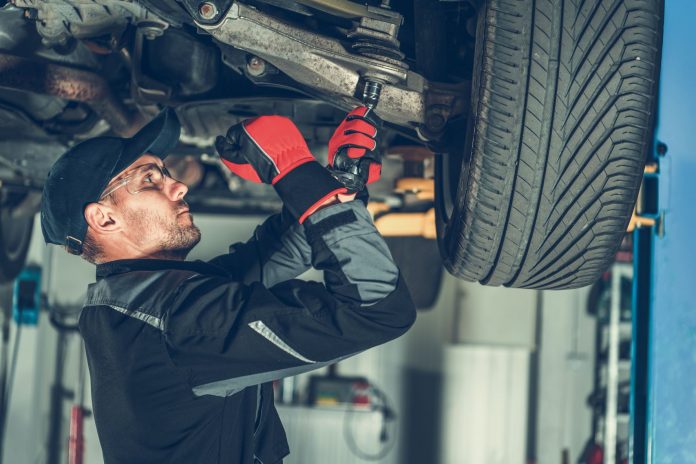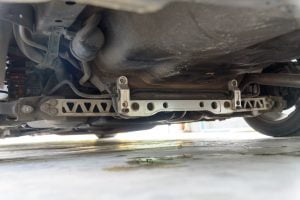Contrary to its name, a sway bar prevents your automobile from rolling over when cornering. That’s why people often prefer to call them stabilizer bars, anti-sway, or anti-roll bars.
A sway bar is an essential car component that needs attention for better car handling and overall performance, no matter how you want to call it. Learn how an anti-roll bar impacts the way your car travels through challenging terrains and busy roads in this post.
What is a sway bar?
A sway bar works in tandem with the vehicle’s suspension system, which is composed of linkages, springs, and shock absorbers, that aim to improve car safety while giving passengers a comfortable ride. This vehicle part is often shaped like a letter U and links both ends of an axle. A sway bar is essentially a piece of metal or a torsion spring that counters twisting force. Each component is attached to each side of the front or rear wheels. (1)
How does a sway bar work?
A sway bar stabilizes tire movements by fastening both ends of the axle, where the wheels are also positioned, preventing a vehicle from rolling over. Because of centrifugal force, the car’s weight transfers outside the turn as the car steers to a corner. When you’re inside a vehicle that’s “rolling,” you’ll notice that your body will lean or sway away from the corner as the car turns. (2)
The anti-roll bar works by applying a force to the opposite side of the vehicle to create a force that counters centrifugal force, helping minimize car roll. It applies force to all sides to help avoid too much swaying. The bar brings the wheels to the same level and keeps the vehicle as close to the ground as possible, helping ensure safety on the road. (2)
As the name implies, an anti-roll bar only works when a vehicle starts to lean or sway to one side, such as when cornering aggressively on twisty roads. Stability and control are critical in vehicle comfort and safety, especially on a corner. Without these features, a vehicle won’t be as responsive while steering. (3)
The stiffer the sway bar, the higher capacity it has to reduce excessive leaning. Some sway bars are adjustable for improved handling. Doing this helps improve car performance without compromising safety by increasing suspension stiffness. In a few cases, off-road drivers prefer to remove their anti-roll bars on challenging tracks. (3)
How a sway bar improves car handling
Car handling refers to the experience drivers and passengers have while using the car and how the vehicle performs on the road. In assessing whether an automobile has handles well, a user must check how the car feels and how much effort it requires to operate, alongside its capacity to keep its passengers safe. Buyers must prioritize these factors whether buying a new or secondhand car. (4)
Too much rolling can impact car safety and handling. For example, a vehicle that sways too much while turning on a corner will likely mess up the alignment of its wheels and minimize traction. On the other hand, a car with finely tuned sway bars will have better grip while applying brakes and cornering because it helps keep your tires on the ground. (3)
A sway bar can also ensure that the vehicle’s load is spread evenly on its wheels, which means less weight is being transferred outside the tire when the car turns. Proper weight distribution means more efficient cornering and a reduced risk of losing traction. (3)
Besides reducing body roll, a sway bar influences overall vehicle handling through adjusting the car’s oversteer or understeer. When turning to a corner, a driver must favor a higher roll rate in the front of the car. If the front sway bars are too stiff, this can lead to understeering. Conversely, firmer rear anti-roll bars cause oversteering. (3)
What is understeering and oversteering?
Oversteering happens when a vehicle excessively leans despite the application of regular steering measures. This occurs when the rear wheels have less grip on the road compared to the front tires. On the other hand, understeering occurs when a vehicle turns way less than expected. It happens when the front wheels lose their grip on the road compared to the rear wheels. As a result, the vehicle sways too much and may spin. (4) (5)
Final thoughts
While sway bars are meant to reduce swaying while turning on a corner, it can help improve car handling and stability because it impacts steering and keeps the wheel firm on the ground.
However, anti-roll bars are only part of the elements to make the driving experience safer and more enjoyable. Suspension and brake systems, tires, and other components impact the vehicle’s comfort and performance too.
References
- “Automotive Suspension Systems”, Source: https://www.cedengineering.com/userfiles/Automotive%20Suspension%20Systems.pdf
- “What Does a Sway Bar Do?” Source: https://www.yourmechanic.com/article/what-does-a-sway-bar-do
- “Lateral Grip: What Sway Bars Actually Do And Why They’re Important”, Source: https://www.streetmusclemag.com/tech-stories/brakes-suspension/lateral-grip-sway-bars-actually-theyre-important/
- “Understanding car handling”, Source: https://www.carbuyer.co.uk/tips-and-advice/156709/understanding-car-handling
- “What is oversteer/understeer? Autoweek explains”, Source: https://www.autoweek.com/news/technology/a1817111/what-oversteer-understeer-autoweek-explains/












